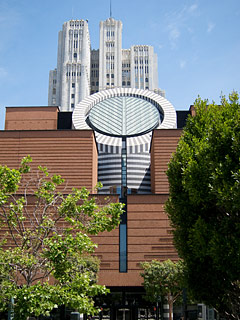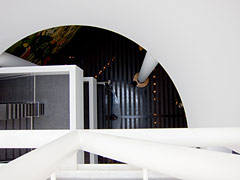Project MoMA: West Coast
Posted: May 4th, 2010 | Author: Nathan | Filed under: field recording[Today’s post is a cross-country collaboration of field recordists, myself  (Mr. Noise Jockey) and Michael Raphael of Sepulchra.com. We’re simultaneously posting recordings from our respective museums of modern art. I visited SFMOMA in San Francisco, and Michael visited the MoMA in New York City. Please read both posts to compare and contrast the recordings and our observations.]

The San Francisco Museum of Modern Art.
The San Francisco Museum of Modern Art was pretty dead when I got there. The bright, sunny day drove most people outside, and it was a bit early in the day. What I recorded, therefore, was as much the sound of the building as the people within it.
SFMOMA is built around a 6-story-tall cylindrical atrium. topped by a suspended interior footbridge. I recorded on each landing of each floor, all the way up to the bridge. I also recorded in a few galleries with varying amounts of people in them. The reverb was astounding, with long decays and high-frequency absorption that made any sound almost a drone. With light attendance, the building channels sound in such a way as to render it calming and enveloping.
Museums tend to be genuflective, introspective places. They have a reputation as being places to whisper, hold your chin and nod as you look upon the works. With this in mind, I found that SFMOMA’s art galleries and its public spaces have related but different acoustic properties.
Overall, the museum’s interior uses hard surfaces to blur sound through constant reverberation. Its gallery design rewards genuflective behavior by being so reverberant that moderate voices blend in with the sound of the air conditioning, but the space is sectioned off into small-enough chunks that loudness is punished by having it carry above the blurred hush, attracting the attention of fellow visitors…and security guards. Its atrium, however, is so vast that all sound is blended together; even young children can squawk and chirp without making other patrons jumpy. This experience left me wondering how an anechoic museum would change patron behavior.

The SFMOMA atrium from the 6th-story footbridge.
On the technique side, I wasn’t sure if I’d have to check my bag at the desk, so I came prepared. In my messenger bag I had my main rig: A Sound Devices 702 recorder with a pair of DPA4060 lavalier mics. I wore a pocket-laden coat with my Zoom H2 and Canon S90 camera, just in case. Thankfully, bags are generally allowed, so I tracked on the 702, but I monitored with iPod earbuds to stay a bit more stealthy. I clipped the 4060’s to each side of my bag, and appeared to read the museum map while recording. This also helped me to focus and stay still during three- to six-minute-long takes.
Today’s sound is a mix of moments from these interior spaces, no processing other than some gain increases.
[soundcloud url=”http://soundcloud.com/noisejockey/project-moma” params=”show_comments=true&auto_play=false&color=dd0000″ width=”100%” height=”81″ ]
[DPA 4060 microphones (spaced-pair stereo) into Sound Devices 702 recorder]
I like the lack of people. It gives the atrium a really open and bright sound.
nice project. as you know I’m interested in this kind of thing, especially since I’m helping organize the Tuned City event in Estonia next year (http://www.tunedcity.net/) which looks at the relationship between architecture and sound.